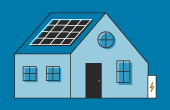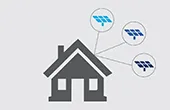New product alert! This week, Generac–the national leader in backup generator solutions-turned clean energy company–added three new releases to their ever-expanding product lines. First, Generac is adding a microinverter option to their existing string & hybrid inverter options for solar installations. The second product is a new backup generator that is designed primarily to recharge PWRcell batteries. And, finally, Generac’s third new product is an energy management system designed to improve and increase battery performance. In this article, we’ll explain what you need to know about these new products.
Continue readingWe read Panasonic’s warranty so you don’t have to
Let’s face it – warranties aren’t the easiest (or most gripping) documents to read. There are often a lot of details and fine print included that can be hard to digest, leaving many to wonder: what does the warranty actually cover? Am I vulnerable? Anything I might be missing?
To make it as easy as possible, we’ve read warranty documents for the top solar equipment manufacturers–and talked to them to confirm what is and isn’t included–and plan to point out the most important aspects of each in a series of articles. In this article, we’ll be breaking down the warranty of one of the most popular solar panel companies in the industry: Panasonic.
Continue readingWe read LG Chem’s battery warranty so you don’t have to
Let’s face it – warranties aren’t the easiest (or most gripping) documents to read. There are often a lot of details and fine print included that can be hard to digest, leaving many to wonder: what does the warranty actually cover? Am I vulnerable? Anything I might be missing?
To make it as easy as possible, we’ve read warranty documents for the top solar battery manufacturers, talked to them to confirm what is and isn’t included, and plan to point out the most important aspects of each in a series of articles. This article reviews the warranty offering from a world renowned electronics manufacturer: LG Chem.
Continue readingWhat is solar energy?
Solar energy is energy from the sun, and it’s the most abundant energy resource on Earth. Solar power can be captured and used in several ways, primarily to generate electrical or thermal energy for homes, businesses, utilities, and more. Solar power is a renewable resource, and as such, is a critical part of our clean energy future.
Continue readingHighlights from LBNL’s 2021 Tracking the Sun report
In case you missed it, solar has been in the news quite a bit recently: the Biden Administration announced a goal for solar to produce 40% of the nation’s electricity by 2030; the Department of Energy released a corresponding Solar Futures Study that lays out just how to reach that lofty goal; the inclusion of clean energy incentives (including for solar!) is at the forefront of the debate around the infrastructure and budget reconciliation bills; the latest Solar Market Insight report from the Solar Energy Industries Association (SEIA) and Wood Mackenzie just dropped; and we recently released our own biannual Marketplace Intel Report. There’s a lot going on!
Amidst this solar news frenzy, Lawrence Berkeley National Laboratory (LBNL) just released their annual Tracking the Sun report, the best resource for tracking the state of residential solar installations in the U.S., and complete with publicly-available data sets with info on nearly 80 percent of all of the solar panel systems installed in the country. Here are some of the highlights from the report:
Continue readingHome battery backup power vs. generators: which is right for you?
If you live in an area with frequent power outages, you already know the benefits of having a backup power supply for your home. Propane, diesel, and natural gas-powered generators have long been the system of choice for homeowners and businesses that want to ensure that the lights stay on when the power goes out in the neighborhood. Now, an increasing number of people are considering newer, cleaner battery options like the Tesla Powerwall.
Continue readingSolar news: September 17th, 2021
In this week’s news roundup, we discuss an important update to solar incentives in Illinois, and a new solar powered electric vehicle (EV) charging facility in California.
Continue readingSolar panel recycling: what you need to know
Solar panels have a lifetime of about 30 years. With the increasing number of solar panels being sold and installed in the U.S. each year, it’s only a matter of time before high volumes of panels are at the end of their useful life and have to be disposed. Solar panel recycling is still at an early stage, but as the solar market continues to expand, recycling processes will have an increasingly important role to play.
Continue readingThe Solar Futures Study: how we can get to 45 percent solar electricity by 2050
On September 8, 2021, President Biden made a big announcement for the solar industry: solar has the potential to power 40 percent of U.S. electricity by 2035, and 45 percent by 2050 – an increase of over 1,000 percent from where it stands today. Produced by the U.S. Department of Energy (DOE) Solar Technologies Office (SETO) and the National Renewable Energy Laboratory (NREL), the Solar Futures Study served as the basis for Biden’s announcement, explaining the role that solar will need to play in decarbonizing the electric grid and how we can achieve these targets in a cost-effective way. In this article, we’ll answer some of the major questions you might have about this study and what this solar transition could look like.
Continue readingSolar news: September 3rd, 2021
In this week’s news roundup, we discuss an expansion in American solar manufacturing capability, and a major addition to the world’s largest solar battery plant.
Continue reading




